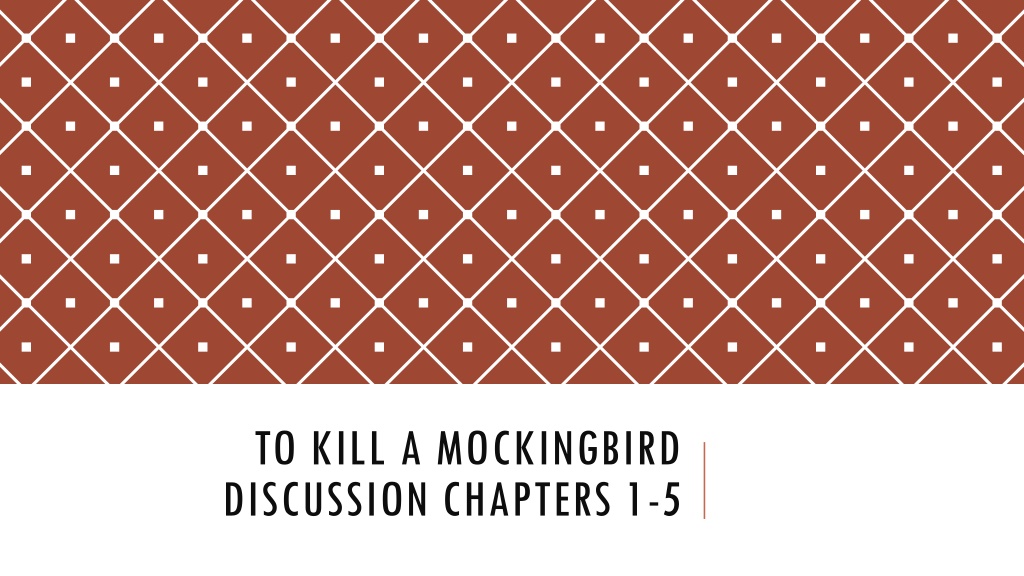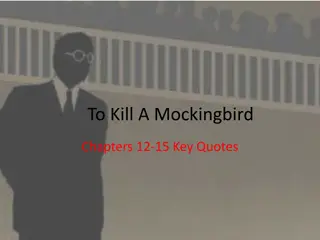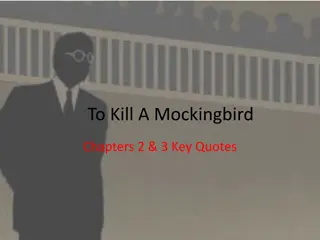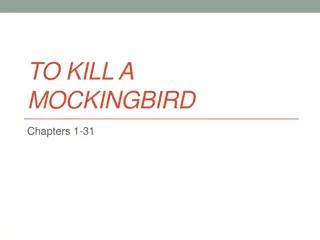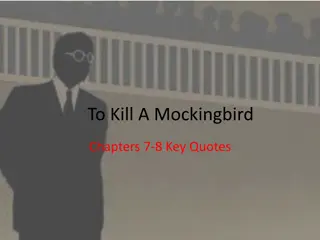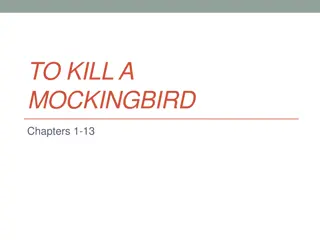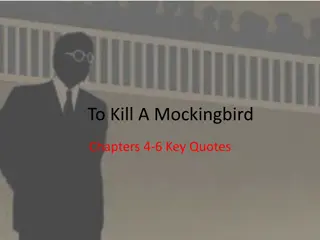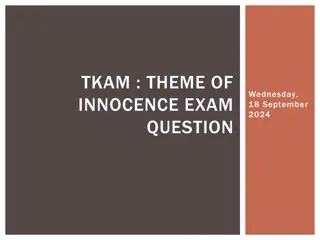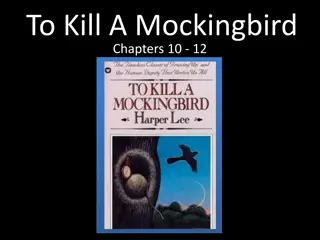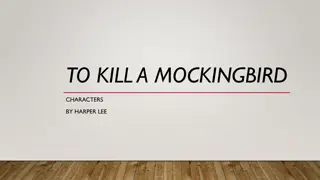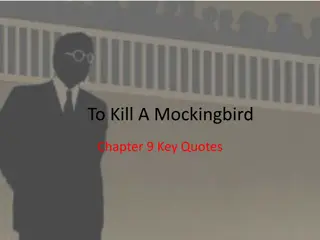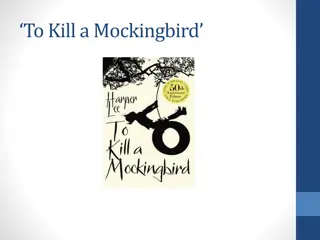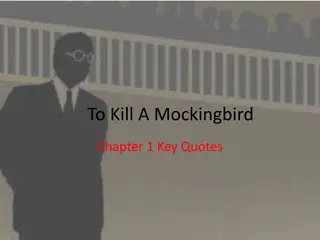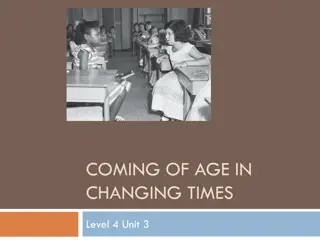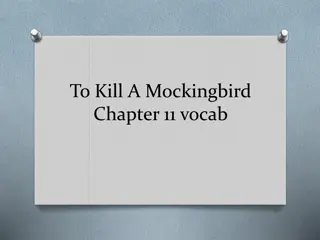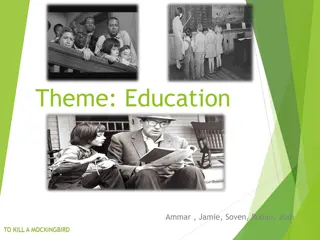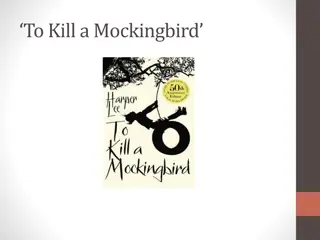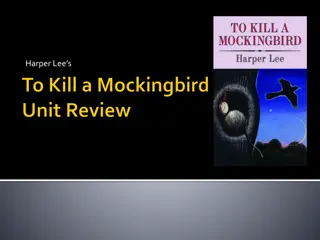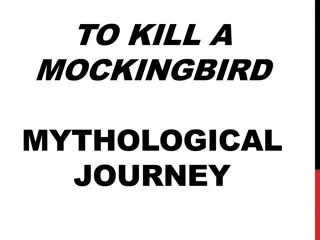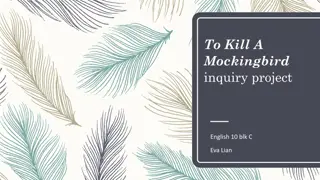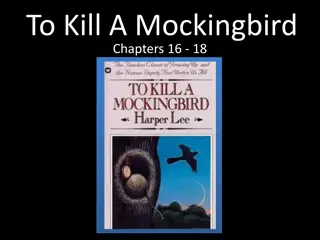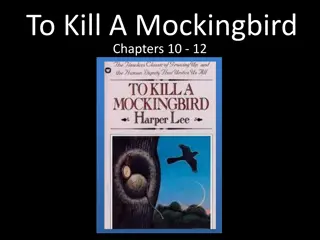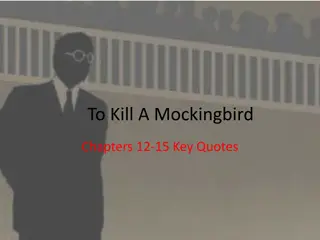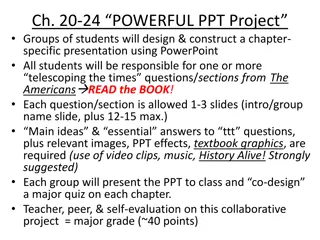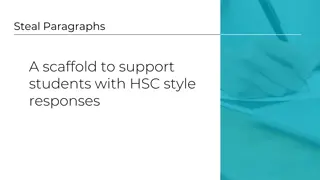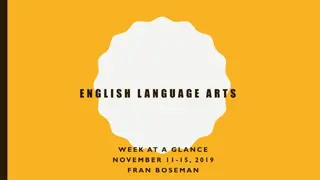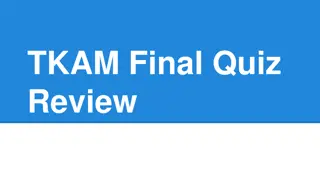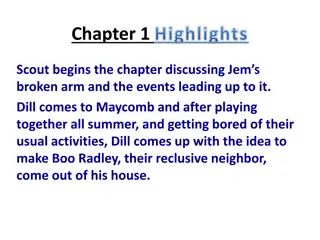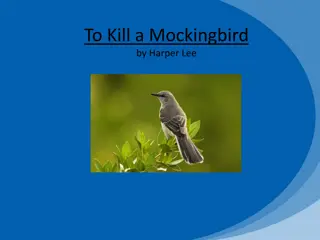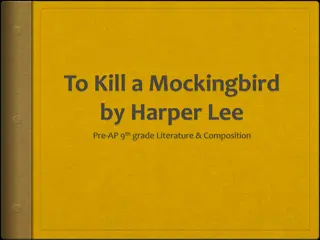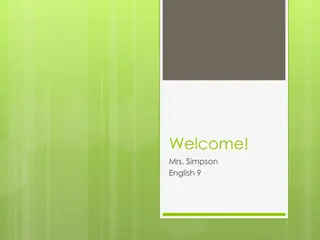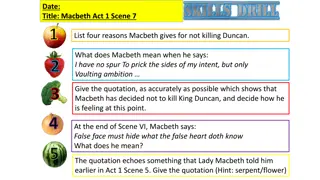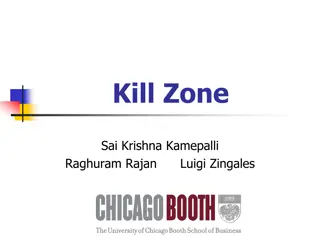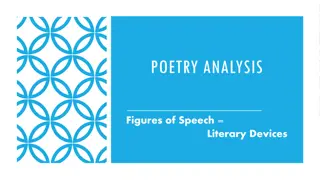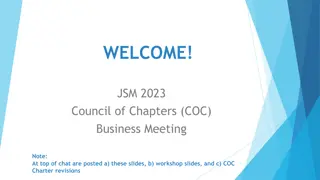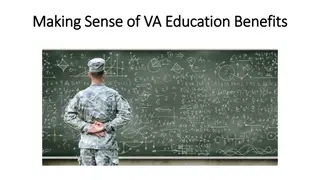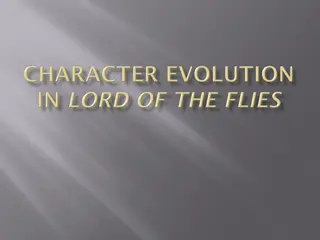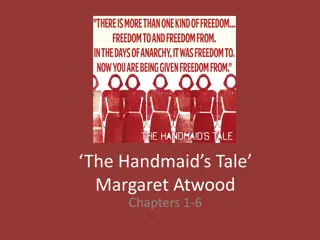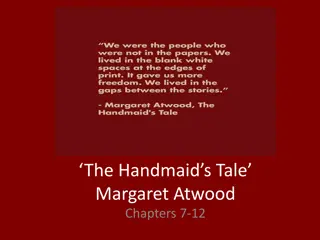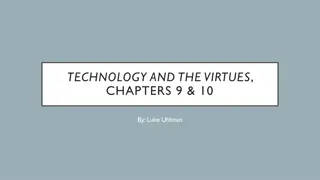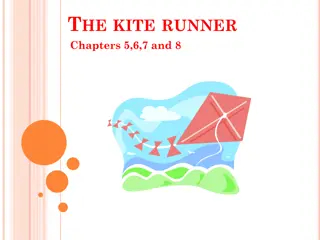To Kill a Mockingbird Discussion: Chapters 1-5
Welcome to the discussion on chapters 1-5 of "To Kill a Mockingbird." In this session, we will cover grammar, pre-assessment, types of questions, small and large group discussions, and the importance of entry questions. Engage with the text by exploring levels of questions and connecting with the characters like Scout and Jem. Get ready to delve deeper into the themes presented in Harper Lee's classic novel.
Download Presentation

Please find below an Image/Link to download the presentation.
The content on the website is provided AS IS for your information and personal use only. It may not be sold, licensed, or shared on other websites without obtaining consent from the author. Download presentation by click this link. If you encounter any issues during the download, it is possible that the publisher has removed the file from their server.
E N D
Presentation Transcript
TO KILL A MOCKINGBIRD DISCUSSION CHAPTERS 1-5
WELCOME! Take out your notebook and To Kill a Mockingbird
WHAT ITS ALL ABOUT Agenda Grammar Pre-assessment Discussion Types of Questions Small Group Large Group Homework: Read Chapter 6 Learning Targets I can use the types of questions to write questions about To Kill a Mockingbird I can engage in a discussion with my classmates.
PRE-TEST GRAMMAR Take out a pen or pencil and clear off your desk. Give it your best shot.
ENTRY QUESTIONS Definition: Entry Questions connect or relate a reader s previous understanding or personal experience to a text. *These questions help readers make connections to the text they are reading.
DISCUSSION: LEVELS OF QUESTIONS Q: How would you feel if there were signs that someone was watching you, reading your mind and leaving you gifts? Entry Level: Connection Questions How can the reader relate to the text? A: If I knew someone was watching, I would feel similar to Scout when she tries to get the others to stop playing. My nagging got the better of Jem eventually, [ ] and to my relief we slowed down the game for a while. [ ] Jem found a way around it: he would simply change the name of the characters (Lee 55). Jem s decision to continue the game and simply change the names would make me very uncomfortable because I would know that this person sees what we are doing and that my actions are not right. I would have to walk away and leave my friends behind and this is difficult.
DISCUSSION: LEVELS OF QUESTIONS Level 1: Level One Questions are literal/in-text questions about facts explicitly/directly/clearly found in texts. *These questions are usually straight- forward and require identifying who, what, where, when, or how about the text.
DISCUSSION: LEVELS OF QUESTIONS Q: How is Miss. Caroline described? A: Miss Caroline was no more than twenty-one. She had bright auburn hair, pink cheeks, and wore crimson fingernail polish. She also wore high-heeled pumps and a red-and- white-striped dress. She looked and smelled like a peppermint drop (Lee 16). Level 1: Literal Questions What does the text say?
DISCUSSION: LEVELS OF QUESTIONS Level 2: Level Two Questions are implied in the text, requiring analysis and interpretation of the text. *Readers must inferor read between the lines for the answers to questions on this level.
DISCUSSION: LEVELS OF QUESTIONS Level 2: Interpretive Questions What does the text mean? Q: Why does Scout want to stop playing the Boo Radley game? A. She found out that Boo has been watching them. Atticus arrival was the second reason I wanted to quit the game. The first reason happened the day I rolled into the Radley front yard [ ] I had heard another sound, so low I could not have heard it from the sidewalk. Someone inside the house was laughing. This made Scout uncomfortable to act out Boo s life if he was watching them.
DISCUSSION: LEVELS OF QUESTIONS Level 3: Level Three Questions are open-ended and evaluating questions that include the text and go beyond it. Theyrequire real world applications. They assume the other levels of questions. *These questions prompt a discussion or examination of an abstract idea or contemporary issue. These are impact questions which ask so what? and why does it matter? .
DISCUSSION: LEVELS OF QUESTIONS Q: Is it appropriate to use corporal punishment sometimes in school? Level 3: Universal Questions Why does it matter? A: According to Scout, on page 28 the class looked back at me in puzzlement then, a storm of laughter broke loose when it finally occurred to the class that Miss Caroline had whipped me. It doesn t make sense to Scout or the class why she is hit with the ruler and often that is the same in school. The punishment should fit the crime . All that happens when physical punishment, or even shaming occurs in the classroom is it turns that student or multiple students off from learning because the trust has been lost with that teacher.
SENTENCE FRAMES Entry Connecting/Relating Questions Level One Literal/In-Text Questions Level Two Interpretive/Inference Questions Level Three Universal, Evaluating/Real World Questions
GROUP QUESTIONS CH 1-5 On a separate piece of paper, write a question and answer for each level. The questions need to go on one side and the answer on the other. In five minutes, we will share these with other groups.
INDIVIDUAL QUESTIONS On a new piece of paper, write a question for each level. When you get the new paper, answer the questions using text evidence.
GROUP DISCUSSION As a group, come up with the best question you have heard today and get ready to pose it to the group to discuss. Tips: These should be level 2/3 questions. These should be questions that people can have multiple perspectives on.
TYPES OF CHARACTERS Protagonist Antagonist Flat Character Round Character Static Character Dynamic Character Foil
PROTAGONIST VS ANTAGONIST: Protagonist: the central, main, most important, or leading character; can be a hero. Antagonist: the person or thing working against the protagonist, or hero.
FLAT CHARACTER: A character represented through only one or two main features or aspects that can often be summed up in a sentence or two.
ROUND CHARACTER: A complex, fully developed character either shown as changing and growing because of what happens to him or her. Is described in such rich detail that we have a clear sense of how she or he would, or will, change even though we don t see it happening.
STATIC CHARACTER: a character who changes very little over the course of a story or narrative. Things do happen to such a character, but little happens within him or her. This character is revealed by the action in the story, but is not changed by it.
DYNAMIC CHARACTER: A character who changes in response to the actions which he or she goes through. One of the objectives of the text is to reveal the consequences of the action upon the character.
FOIL: A character who serves, acts, or functions as a contrast or challenge to another character. A foil is used to highlight another character s personality or character traits.
TYPES OF CHARACTERS Protagonist Antagonist Flat Character Round Character Static Character Dynamic Character Foil
EXIT SLIP 1. Review from last year, what is direct characterization? 2. How do we create character; what are the types of indirect characterization? Homework: Read Chapter 6 and write a dialectic journal with 3-5 entries
